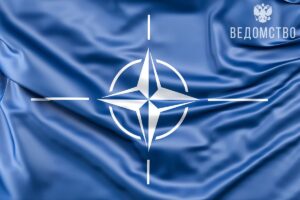These days, Cyprus remembers the events of half a century ago, which for many decades determined the appearance of the island. On July 20, 1974, Turkey launched an invasion of the island, motivating its move by the need to protect part of the local population. 50 years have passed since the final split between Greek Cypriots and Turkish Cypriots, and the island is still divided by the so-called green Line, which crosses, among other things, the capital of Cyprus, Nicosia. There is still no need to talk about progress in resolving the conflict, although international mediators still do not despair.
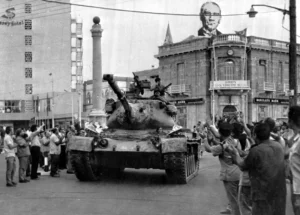
“Peaceful” intervention
On the evening of July 19, 1974, the operator of the radar station at Cape Apostol Andrew in the northeastern part of Cyprus, Giorgis Kremastoulis, noticed landing craft moving towards Cyprus from the Turkish Mersin. “I was watching on the radar for targets that were on the territory of Turkey, and after half an hour I noticed that these points were moving and decreasing (on the radar monitor.— Kommersant),” he later recalled in an interview with the Greek newspaper Kathimerini. — It was at that moment that I realized that something was happening, and I started providing reports every half hour.”
At 5:30 a.m., the realization that something was going on came to the residents of the entire northern part of the island. At that moment, the sounds of a civil defense siren rolled through Cyprus. An hour later, military music sounded on Cypriot television, and after that all citizens capable of carrying weapons were called to join the National Guard units to resist the Turks, who began landing on Pentemili beach at dawn.
The Turkish side will call its actions a “peacekeeping operation in Cyprus,” and the Greek population of the island will remember those events as an invasion and will annually honor the memory of their fellow citizens who died then, waking up on July 20 to the sounds of funeral sirens.
In the first hours of the operation, about 3 thousand Turks landed on the island. “I remember all these parachutes coming down; it was like butterflies flying,” American diplomat James Alan Williams, who stayed in Cyprus with his family in 1973-1975, would later say.— It’s pretty surreal. I’ve never seen anything like this before.”
Once on Cypriot soil, the Turks first captured an abandoned airfield in Krini, which they planned to use for the transfer of other battalions. Meanwhile, the Turkish navy took care to block the routes for Greek military aid: the ports of Limassol and Paphos were blocked. However, the primary task of the military was to take control of the only road connecting Kyrenia (in the north of the island) and Nicosia, which would allow maintaining access to supply sources. It was possible to do this by the end of the day thanks to coordination with the Turkish Cypriot militias.
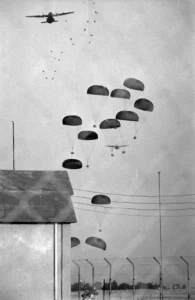
Photo: Getty Images
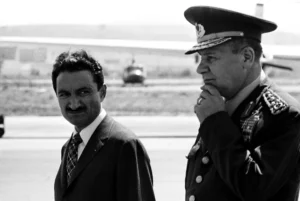
Фото: КАГАТАЙ / Гамма-Рафо / Getty Images
By the time Turkish Prime Minister Bulent Ejevit informed the nation about the start of the “peacekeeping operation”, speaking on a Turkish radio station, the Cypriot armed forces were already preparing for resistance. They sent two high-speed attack boats to the Turkish fleet, which, however, were almost immediately neutralized, made several attempts at artillery attacks and soon launched an offensive against Turkish enclaves in different parts of the island.
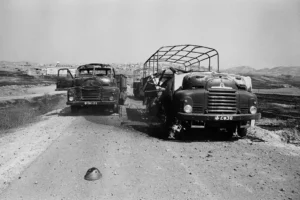
Photo by Michele LAURENT / Gamma-Rapho / Getty Images
Just a few hours after the invasion, the junta in power in Greece announced a general mobilization. Prime Minister Adamantios Andrutsopoulos condemned Turkey’s actions, calling them “a blatant violation of international treaties concerning Cyprus.”
His statement claimed that the Turkish campaign “threatens international peace and the vital interests of Greece,” and that Greece will “defend its legitimate rights and national interests at all costs.”
In the book “Operation Attila Line”: The landing campaign in Cyprus, 1974″ retired U.S. Army officer, employee of International Research Associates (Washington State) Edward J. Erickson noted that the reaction of the National Guard of Cyprus to the invasion was “episodic and belated,” and the reaction of the Greek command was “lightning fast, but poorly coordinated.” Ultimately, the author writes, this led to the fact that at the first stage the Greeks were unable to provide the well-coordinated leadership necessary for effective defense against the Turks. As a result, the island split into two parts, and it is still not possible to glue them together.
On the way to a split
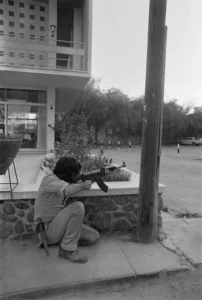
Photo: Xavier Baron / AFP
The relations between the Greeks and Turks who lived on the island of Cyprus have never been warm, but for several centuries after Cyprus became part of the Ottoman Empire, they more or less peacefully coexisted with each other. Everything changed in the 1830s, when, with the support of the Greek government, the former Greek lands that remained under Turkish rule began to demand reunification with Greece. Cyprus was among them.
The rise of nationalist sentiment among the Greek population of Cyprus occurred in the 1920s, when London officially declared the island a possession of the British Crown. By 1955, a terrorist movement was formed on the island, advocating the secession of Cyprus from the British Empire and seeking to unite the island with Greece, EOKA. It is the nationalists within the EOKA who will cross the line and launch attacks on Turkish Cypriots who do not support Enosis, the course of uniting the island with Greece.
In the late 1950s, EOKA openly rebelled against British rule. Realizing that Cyprus was steadily sliding towards war, the British decided to grant the island independence. However, this step did not bring the Cypriots any closer to reunification with Greece: the Turkish community did not agree with this scenario.
In the end, in order to avoid a direct clash with the Turks, Archbishop Makarios III, who had been at the head of the Church of Cyprus since 1950, agreed to the independence of the island as an alternative to an alliance with Greece.
Cyprus became independent on August 16, 1960. But the confrontation between the two communities has not disappeared. The Greeks continued to advocate enosis, while the Turks insisted on dividing the island. To satisfy both sides, the Greek and Turkish communities, together with the United Kingdom, Turkey and Greece, drafted a constitution that emphasized the principle of guaranteeing the rights and freedoms of the Turkish minority. The Basic Law granted the two peoples equal political rights and status, but implied certain proportions of representation of the Greek and Turkish populations in the main authorities (70:30) and in the army (60:40).
Ankara is lobbying for the recognition of the Turkish Republic of Northern Cyprus
One of the main features of the constitution was that London, Athens and Ankara acted as guarantors of the new system and pledged to support the “sovereignty, territorial integrity and independence” of Cyprus. At the same time, the guarantor countries have the right, under certain circumstances, to interfere in the affairs of the island State. Article IV of the Guarantee Agreement read as follows: “To the extent that common or concerted action may not be possible, each of the three guarantor Powers reserves the right to take action for the sole purpose of restoring the state of affairs created by this treaty.”
Ankara used this right in the summer of 1974. On the morning of July 20, the Turkish ambassadors in Athens and London handed over notes stating that Turkey, as the guarantor country of the status of the Republic of Cyprus, was forced to resort to force due to the threat of changing the constitutional status and protection of Turkish Cypriots hanging over the island.
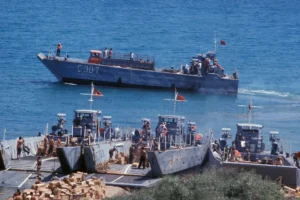
Photo by Michele LAURENT / Gamma-Rapho / Getty Images
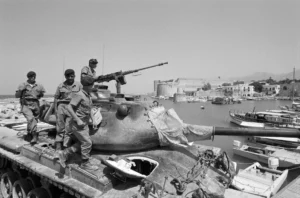
Photo by David Rubinger / Corbis / Getty Images
The reason was the events that happened shortly before. In the spring of 1974, Archbishop Makarios III, who became the first president of independent Cyprus, learned that the paramilitary organization EOKA-B, supported by the Greek military junta (the period of its dictatorship went down in Greek history as the regime of the “black colonels”), led by President Fedon Gizikis, was preparing a coup against the current Cypriot government. On July 2, the Archbishop, in an open letter to President Gizikis, condemned Greece’s support for EOKA-B and demanded the removal of Greek officers from the posts of the National Guard of Cyprus, which was controlled by the Greek junta. Greece ignored these requests. Moreover, on July 15, at 8:20 a.m., National Guard detachments attacked the Cypriot Presidential Palace and the national Government building. “There was no doubt that they (the military who staged the coup.— Kommersant) tried to kill him (Makarios.— Kommersant), — James Alan Williams is sure. – During the attack by the National Guard forces, the presidential palace was turned into burning ruins within a few hours.” Makarios nevertheless managed to escape. Storming the presidential palace, the military dismissed the government and proclaimed the new president of the Greek nationalist, supporter of enosis Nikos Sampson.
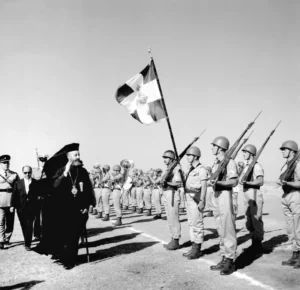
Photo: CENTRAL PRESS / AFP

Photo: Harry Dempster / Express /
“Due to the reputation of a fierce Greek Cypriot nationalist, the leader of the EOKA movement and a man who boasted of what he had done in the fight against the Turkish Cypriots (during the civil war in Cyprus in the early 1960s.- Kommersant), the appointment of Nikos Sampson as president of Cyprus was very similar to waving a red flag in front of the Turkish bull,” noted James Alan Williams. As a result, the bull went on the attack.
By attacking Cyprus, the Turkish military quickly established control over the island’s airspace and secured an advantage at sea. By the end of the day, up to 6 thousand troops were deployed to the island, and in the following days their number increased to 40 thousand. At first, the Cypriot National Guard managed to contain the enemy. The military stopped the offensive and repelled the attack on Nicosia.
However, on July 24, another coup took place in Greece, as a result of which the regime of the military junta, which had been in power since 1967, fell. For the Greek Cypriots, this meant that counting on help from Athens was now virtually meaningless.
The Greek crisis, on the contrary, played into Ankara’s hands. Realizing that there was no need to fear a declaration of war from Greece, weakened from within, the Turks continued their offensive. According to various estimates, during the operation, Turkey used a third of its infantry, most of its naval forces and almost all of its aircraft. And not in vain. During a month of active hostilities, the territory controlled by Turkish troops grew more than fivefold — by mid-August they had captured 36% of the island’s territory. By August 18, having reached the Atilla line, proposed by the Turkish government as the border between the Turkish and Greek parts of the island, the Turks announced a cease-fire. From that day on, the rumble of shells in the northern part of the island subsided, but the problems continued to multiply.
In search of consensus

Photo: AP
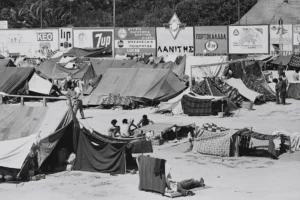
Photo: Michel LAURENT / Gamma-
Since the beginning of the Turkish invasion, from 160 thousand to 200 thousand Greeks, who made up more than 80% of the population of the Turkish-occupied part of Cyprus, were forced to flee to the south. Due to discrimination, harassment and intimidation, the outflow of Greek Cypriots from the north of the island continued in subsequent years. The official Turkish administration also played a role, which, after the end of hostilities, launched resettlement programs for Turks, primarily farmers, to the north of Cyprus. The Government of Northern Cyprus has provided many Turkish settlers with houses and lands previously owned by Greek Cypriots. All this radically changed the demographic picture of the island and led to the final disintegration of the two communities.
The year 1974 divided the island not only geographically and demographically — it defined different vectors of political and economic development of its Greek and Turkish parts. Greek Cyprus has been busy rebuilding the economy, which was destroyed after the Turkish attack, and has begun to make its way to the European Union.

Photo by Chip HIRES / Gamma-Rapho / Getty Images
Turkish Cyprus has followed the path of creating an unrecognized state. In 1983, the Turkish Republic of Northern Cyprus (TRNC) was proclaimed in the territories controlled by the Turks. The UN Security Council condemned this step in resolution 541, calling on the UN countries to “respect the sovereignty, independence, territorial integrity of the Republic of Cyprus” and “not recognize any Cypriot state other than the Republic of Cyprus.” The formation has not yet been recognized by any country except Turkey.
The unilateral proclamation of the Turkish Republic of Northern Cyprus is a turning point in the Cyprus settlement.
Before that, the Greek and Turkish communities, with the assistance of the UN Secretary General, tried with varying success to find a solution that would take into account the interests of both peoples and would allow them to coexist within the framework of one state. In the late 1970s, when the leaders of the island’s two communities signed agreements that fixed the principles and foundations of the transformation of the state into a bicommunal bi-zonal federal republic, it even seemed that they were approaching a compromise. However, the appearance of an unrecognized state in the north of the island froze the process of finding a mutually acceptable solution for a long time.
Negotiations between the Greeks and Turks intensified only in the 1990s, when in 1994 the Republic of Cyprus received a positive response to its application to become a member of the European Union. The country was ready to be admitted to the EU in ten years, provided the conflict was resolved.
After several rounds of fruitless negotiations, UN Secretary General Kofi Annan attempted to find common ground between the two peoples inhabiting Cyprus. In 2002, he presented a comprehensive plan, proposing to transform the island state into a federation of two states with equal representation of communities in the upper house of Parliament and an ethnic rotation of presidents and vice presidents.
The Republic of Cyprus has strongly opposed the “Annan plan”. On the eve of the 2004 referendum on unification, Cypriot President Tassos Papadopoulos appealed to the population to reject the proposal of the UN Secretary General. “I urge you to say a decisive “no” to this plan at the referendum on April 24. I urge you to protect your rights, your dignity, your history,” he said. The leader of Northern Cyprus, Rauf Denktash, also called the plan unacceptable. “They (Greek Cypriots.— Kommersant) will not need a settlement as long as the world treats them as the government of the entire island,” he said, calling the plan “a recipe for Greek domination over the Turkish minority.”
Despite Rauf Denktash’s warnings, the plan won the support of Turkish Cypriots (64.9% for and 35.1% against), but was rejected by Greek Cypriots (24.2% for and 75.8% against). They considered the plan to be pro-Turkish due to the lack of references to the need to evict Turkish migrants, as well as the lack of requirements for Turkey to withdraw troops from the island in a timely manner. “This is not a day of joy, but it is not a day of sorrow either. We didn’t say no to solving the problem. We simply rejected a specific plan with its specific shortcomings,” Tassos Papadopoulos said after the vote. “There were no mourners on the Greek part of the island after the announcement of the referendum results. But there were enough rejoicing. All night long, people drove around in cars, honked and waved national flags, and the next morning most of the newspapers came out with headlines that featured the word “victory”,”Kommersant” described the mood on the island that day.

Photo: Fatih Saribas FS / CRB / Reuters
A completely different mood, Kommersant continued, “prevailed on the other side of the UN dividing line”: “Turkish Cypriots went to the referendum with a different feeling. Most of them saw unification as a chance to break out of a quarter-century of political and economic isolation.” It is precisely this episode that the Turks will later actively recall to the Greeks and use in support of their position of abandoning the federal state.
“The Turkish side has always proceeded from the principle of federalization of the island,” Togrul Ismail, head of the Department of Political Science and International Relations at Kahramanmarash University, told Kommersant.”But when the Greek Cypriots rejected Kofi Annan’s proposal, Turkey had to support the Turkish Cypriots in the creation of an independent state.” “Why? Because the Greek Cypriots themselves abandoned the two-communal system of government.— “Kommersant”),— explains the Turkish political scientist. And adds:— Turkish Cypriots have to live somewhere. If the Greek side refuses the federal plan, what is left for them? To voluntarily surrender so that they can be exterminated in the future?”
Vanishing opportunities
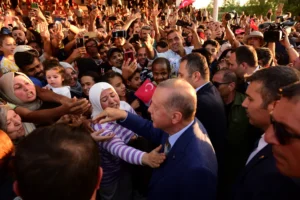
Photo: Nedim Enginsoy / AP
The concept of a bicommunal federation, agreed upon during negotiations between the two communities in the 1970s, was replaced by the idea of two autonomous states. Ankara began to formulate it after an unsuccessful informal summit in Crans-Montana in 2017, following which UN Secretary General Antonio Guterres stated that “the conference on Cyprus ended without reaching an agreement.”
According to Erol Kaymak, an employee of the German Institute for International Relations and Security, “the change of leadership in the Turkish Cypriot community in 2020, combined with the re-election of Recep Tayyip Erdogan as president of Turkey in 2023, intensified the shift in the positions of Turkish Cypriots and Turkey in favor of a two-state solution.”
Since 2021, the Turkish leader has openly promoted this vision at meetings of the UN General Assembly and beyond. Turkey’s next message to the UN member states was voiced at the general political debate of the 78th session of the General Assembly in September 2023. Then Recep Tayyip Erdogan called on the countries to recognize the independence of the TRNC and establish diplomatic, political and economic relations with it, while stressing: “Despite the sincere efforts of the Turkish Cypriots, the fact remains that a federal solution on the island cannot be achieved.”
President Erdogan opposed the unification of Cyprus
Mr. Erdogan’s trip to Northern Cyprus in June 2023 was indicative — his first official visit after his re-election. At a joint press conference with TRNC President Ersin Tatar, he said that Ankara would continue to defend the interests of the Turkish Republic of Northern Cyprus in the Eastern Mediterranean. “More than half a century has been lost in Cyprus due to the maximalism and uncompromising position of the Greek community of Cyprus. No one will allow another 50 years to be lost,” Recep Tayyip Erdogan said. He stressed that Turkey’s policy in the region “is based on the desire for peace.”
At the same time, the country, taking advantage of the uncertainty of the political status of the northern part of Cyprus, continues to strengthen its presence on the island in various forms. So, in 2020, the Turkish state-owned company Turkish Petroleum began drilling wells offshore Northern Cyprus, which caused the indignation of its Greek neighbors. And in 2022, the Turks deployed attack and reconnaissance drones on the island, justifying this by the need to “completely secure the Turkish Republic of Northern Cyprus from all directions.”
In turn, Greek Cyprus continues to insist on finding a solution “based on high-level agreements, decisions and resolutions of the UN Security Council and in accordance with the principles and values of the EU.” In other words, the Greek Cypriots do not abandon the idea of a federal state.
The irreconcilability of the positions of the two Cypriot administrations still does not allow the resumption of the negotiation process at the official level.
In words, both sides declare that they are ready for negotiations, but in practice each has put forward conditions that the opposite considers unacceptable. One thing is invariably the mutual accusations of the parties in the troubles of the Cypriots.
Nevertheless, attempts to find a mutually acceptable solution do not stop. So, in recent months, Maria Angela Holguin has actively manifested herself, whom UN Secretary General Antonio Guterres appointed his representative on the Cyprus issue on January 5. Mr. Guterres asked her to find common ground between the parties to the conflict “on the way forward” and give him recommendations on the Cyprus issue.
Prior to that, Maria Angela Holguin, as head of Colombian diplomacy (2010-2018), became famous for her direct participation in solving an equally complex and equally long—lasting conflict between the Colombian authorities and the fighters of the FARC group. Everyone who wrote about Ms. Holgin at the beginning of the year paid attention to such a success story. Over the past months, she has met several times with Greek Cypriot and Turkish Cypriot leaders Nikos Christodoulides and Ersin Tatar, and on July 10 she handed over her final report to Antonio Guterres.
A few days before, Ms. Holgin published a programmatic open letter in which she said that she had devoted the last months to “constantly searching for ways leading to the establishment of trust between the parties.” “It is important to move away from decisions that in the past were associated with expectations, which in the end were not justified and led to even greater disagreements and disappointments. Now we must think differently, remaining convinced that a common future will bring great opportunities to all Cypriots,” Maria Angela Holguin urged.— Too many years have been spent on confrontation and discrimination. It took too much time to recriminate each other. The status quo has led to an increase in distance between the parties and ignorance of each other, and this is getting worse every day.” According to her, many residents of the island “seem to have given up” and consider it impossible to change the situation. But this, according to the diplomat, is only such a protective mechanism for long-disappointed people. “When people constantly talk about the painful past, they cannot be open to change and believe in a hopeful, common and better future,” she concluded, urging to abandon such thinking.
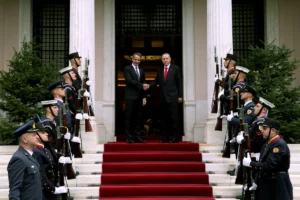
Фото: Thanassis Stavrakis / AP
The possibility of at least some progress is indicated, in particular, by the de-escalation in relations between Turkey and Greece. The new chapter opened on December 7, 2023, during a meeting between Greek Prime Minister Kyriakos Mitsotakis and Recep Tayyip Erdogan. At that time, 16 documents were signed in Athens, including the declaration on friendship and good-neighborly relations. A return visit to Ankara took place in May. “The positive climate between Athens and Ankara inevitably helps our own efforts to resolve (the Cyprus problem.— Kommersant),” Nikos Christodoulides said the other day. The President of Cyprus also acknowledged that maintaining the current status quo on the island cannot be a solution to the problem.
According to the Cypriot media, the special envoy of the Secretary General hopes that Antonio Guterres will be able to persuade all parties to hold a new trilateral (UN, Republic of Cyprus, TRNC) or five-sided (with the participation of Greece and Turkey) meeting, which in itself will be a breakthrough. This may happen on the sidelines of the high-level week of the UN General Assembly (it traditionally takes place in September) or shortly after it.
And the stakes are as high as possible right now. As Antonio Guterres warned back in January, “the possibilities of finding a solution that each side can take are gradually disappearing.”
Anastasia Dombitskaya, Pavel Tarasenko



